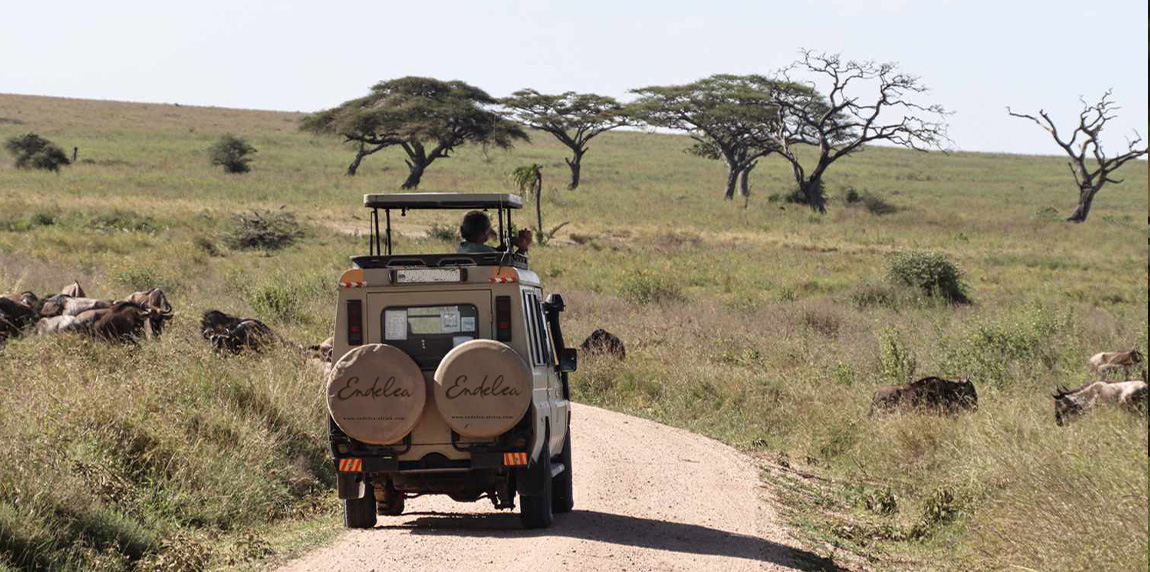Serengeti National Park is arguably one of the oldest and most well known safari destinations. It’s located in the Mara region and people come from all over the world to have a chance of witnessing the captivating Great Migration. An incomparable experience of feeling the vibration of over a million Wildebeest, as well as hundreds of thousands of zebras and gazelles, making their was through the Serengeti plains, as they travel through to the Masai Mara. You may also be lucky enough to witness incredible river crossings, featuring dramatic currents and stealthy crocodiles.
The park is also famous for its abundant wildlife, including the "Big Five" (lions, elephants, buffalo, leopards, and rhinoceros), cheetahs, giraffes, zebras, and numerous antelope species. Safari game drives are the most popular way to explore the park, with opportunities for both daytime and night safaris, the latter offering a chance to observe nocturnal wildlife like hyenas and lions. For a truly unique experience, a hot air balloon ride at dawn allows visitors to drift silently over the Serengeti plains, offering aerial views of the wildlife and landscapes, followed by a champagne breakfast. Walking safaris are also available, giving guests a chance to experience the bush up close and learn about the smaller details of the ecosystem. Additionally, many visitors take part in cultural tours, visiting Maasai villages to gain insight into the indigenous people’s traditions, lifestyle, and their connection to the land and animals. The park’s vast landscapes and diverse wildlife also make it a photographer's dream, particularly during sunrise and sunset.
The UNESCO World Heritage Site is not only a wildlife haven but also a region rich in history and culture. The park's name, Serengeti, comes from the Maasai language, meaning "endless plains," a fitting description of its vast, expansive savannahs that stretch as far as the eye can see. The area’s significance goes beyond its natural beauty; it holds deep cultural and historical importance for the Maasai people, who have lived in harmony with the land for centuries. Their traditional practices and knowledge of the environment, from animal tracking to sustainable herding, have helped preserve Serengeti's ecosystem for generations.
One of the highlights of visiting Serengeti is the opportunity to immerse oneself in the region’s cultural experiences. Maasai village tours are a popular way for tourists to learn about the indigenous Maasai people. Visitors can witness traditional dances, learn about Maasai customs, and experience firsthand their way of life, which revolves around cattle herding and a deep respect for nature. The Maasai’s semi-nomadic lifestyle and strong spiritual connection to the land have allowed them to live alongside the wildlife of Serengeti for centuries, and many Maasai still live in and around the park today. These visits often include a walk through the villages, where guests can see traditional Maasai houses (known as enkangs) made from mud, sticks, and grass, and observe local crafts like beadwork and basket weaving.
Additionally, many lodges and camps within Serengeti offer cultural immersion programs, where guests can participate in Maasai-led workshops, learn about traditional agricultural methods, or engage in storytelling sessions that pass down ancient myths and legends about the land. These cultural experiences provide a deeper understanding of how the Maasai people have lived alongside the park's wildlife and their role in conservation efforts today. With its fascinating cultural and historical context, Serengeti is not just a place to witness one of the world’s greatest wildlife spectacles but also an opportunity to connect with the land's deep-rooted traditions and human history.
Serengeti’s history is also intertwined with conservation efforts, as the park’s establishment was crucial in protecting its incredible biodiversity. The area was initially set aside as a game reserve in the early 20th century, with formal recognition as Serengeti National Park in 1951. Its creation followed the realization that the vast ecosystem, particularly the Great Migration of wildebeest, zebras, and gazelles, needed protection to preserve the natural cycles that had existed for millennia. Over time, Serengeti became a model for wildlife conservation in Africa, with the park’s ecosystem protected from hunting, agriculture, and development. This historical push toward conservation was critical not only for preserving Serengeti’s wildlife but also for maintaining the ecological balance of the greater Serengeti-Mara ecosystem, which spans across both Tanzania and Kenya.
When it comes to the best time to visit the park, this can be planned around what aspect of the migration you want to witness. From December to March, the southern plains of Serengeti are the scene of the calving season, when wildebeest give birth in large numbers, attracting predators. This is a quieter time in the park, offering a more peaceful experience, where plenty of wildlife can be seen, although the herds are not yet on the move. The rainy season (April to May) follows, and while the park is lush and green, the migration is not in full swing, and the heavy rains can make travel challenging. For those wanting to see the migration in full motion, the best time is between June and July, when the herds begin their northward journey towards the Masai Mara. This is an ideal time for spotting large herds and predators. The peak migration period occurs from August to October, when the wildebeest attempt dramatic river crossings at the Mara River. These crossings, where the herds face crocodiles and powerful currents, provide some of the most thrilling wildlife spectacles. However, this is also the high season, so the park can be crowded. Finally, November marks the transition period, with the herds beginning their southward movement back to Serengeti. Although the migration is winding down, it's still possible to see large groups of wildebeest and zebras in the park.
